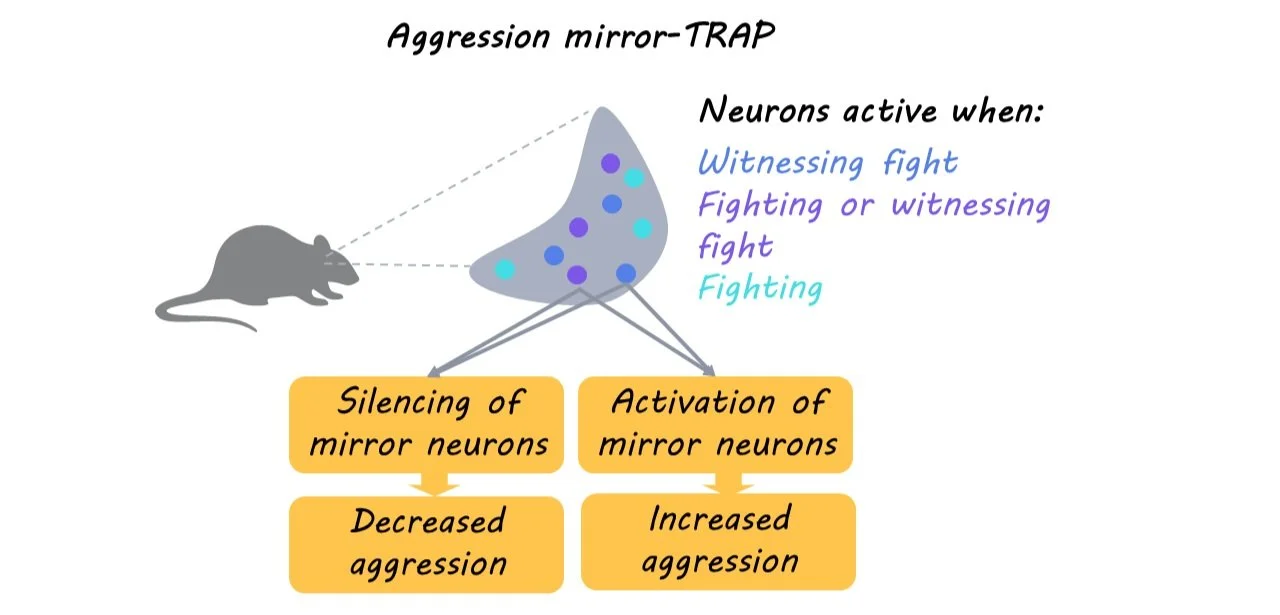Aggression-Specific Mirror Neurons Exist in the Hypothalamus
Post by Lincoln Tracy
The takeaway
A subset of neurons essential for aggression in the ventromedial hypothalamus of the mouse is activated when observing aggression in other animals, providing an example of mirror neurons for this specific social behavior.
What's the science?
Mirror neurons are a subtype of neurons activated both during seeing and undertaking a behavior. Consequently, they have been suggested to be an important component of the cognitive substrates underlying successful social interactions. Activating neurons in the ventrolateral section of the ventromedial hypothalamus – the ‘attack’ center of the brain – elicits aggression in mice, but it’s unknown whether these neurons are also activated when observing aggression between other animals. This week in Cell, Yang and colleagues used calcium imaging and multiple types of genetically modified mice to determine whether neurons in the ventrolateral section of the ventromedial hypothalamus could perceive aggressive encounters between other mice.
How did they do it?
First, the authors used fiber photometry to determine whether aggressor neurons in the ventromedial hypothalamus of male mice were activated in response to social interactions with a male intruder in their cage. Second, they tested whether observing, but not participating in, aggression between two other mice activated the neurons in a similar fashion by separating the mice with clear, perforated plastic partition. Third, they tested which specific aspects of observing aggression were required for neuronal activation by altering the mice’s ability to smell and see the other animals. Fourth, they used socially naïve and experienced males to determine whether aggression mirroring requires the mouse to have previously participated in aggressive behaviors. Fifth, they used a TRAP2 mouse model to specifically test whether neurons activated in observers were also activated when the mouse participated in aggressive behaviors. Finally, they tested if the aggression-mirroring neurons were functionally relevant for fighting by using an aggression mirror-TRAP (aggression mirror neurons tagged with TRAP) to inhibit these neurons in a territorial aggression paradigm.
What did they find?
First, the authors found aggressor neurons in the ventromedial hypothalamus of male mice were activated when a mouse interacted with and attacked a male intruder that had been placed in its cage. Second, just as when the mouse participated in aggressive behaviors, observing other mice be aggressive resulted in similar activation of ventromedial hypothalamic neurons. Third, they found that visual input is necessary for the activation of aggression-mirroring hypothalamic neurons, as repeating the experiment under infrared light did not activate aggressor neurons. Fourth, they found prior experience was not needed, as ventromedial hypothalamic activation was similar for both socially naïve and experienced mice when observing aggressive behaviors between other mice. Fifth, they found that there was an overlap of ventromedial hypothalamic neurons that were activated in observers and participants of aggression. Finally, they found the aggression mirroring neurons were essential for territorial fighting, as forced inhibition of these neurons reduced aggressive, but not non-aggressive social, behaviors. In additional studies, they also found that activating aggression mirroring neurons was sufficient to elicit aggression.
What's the impact?
These findings provide a genetic platform that can help us gain molecular and cellular insights into how individual neurons represent social behavior like aggression with respect to both mirroring and performing actions.


